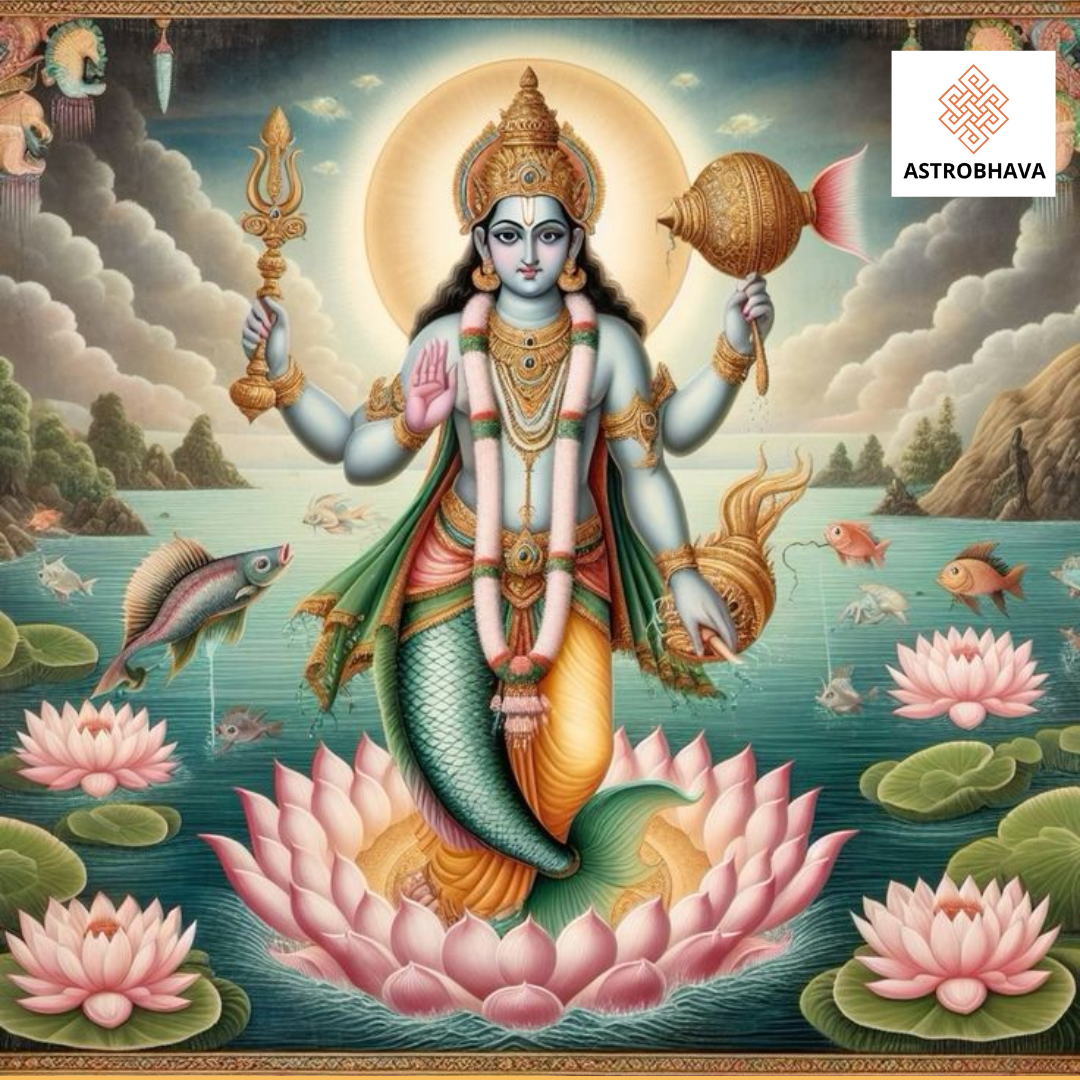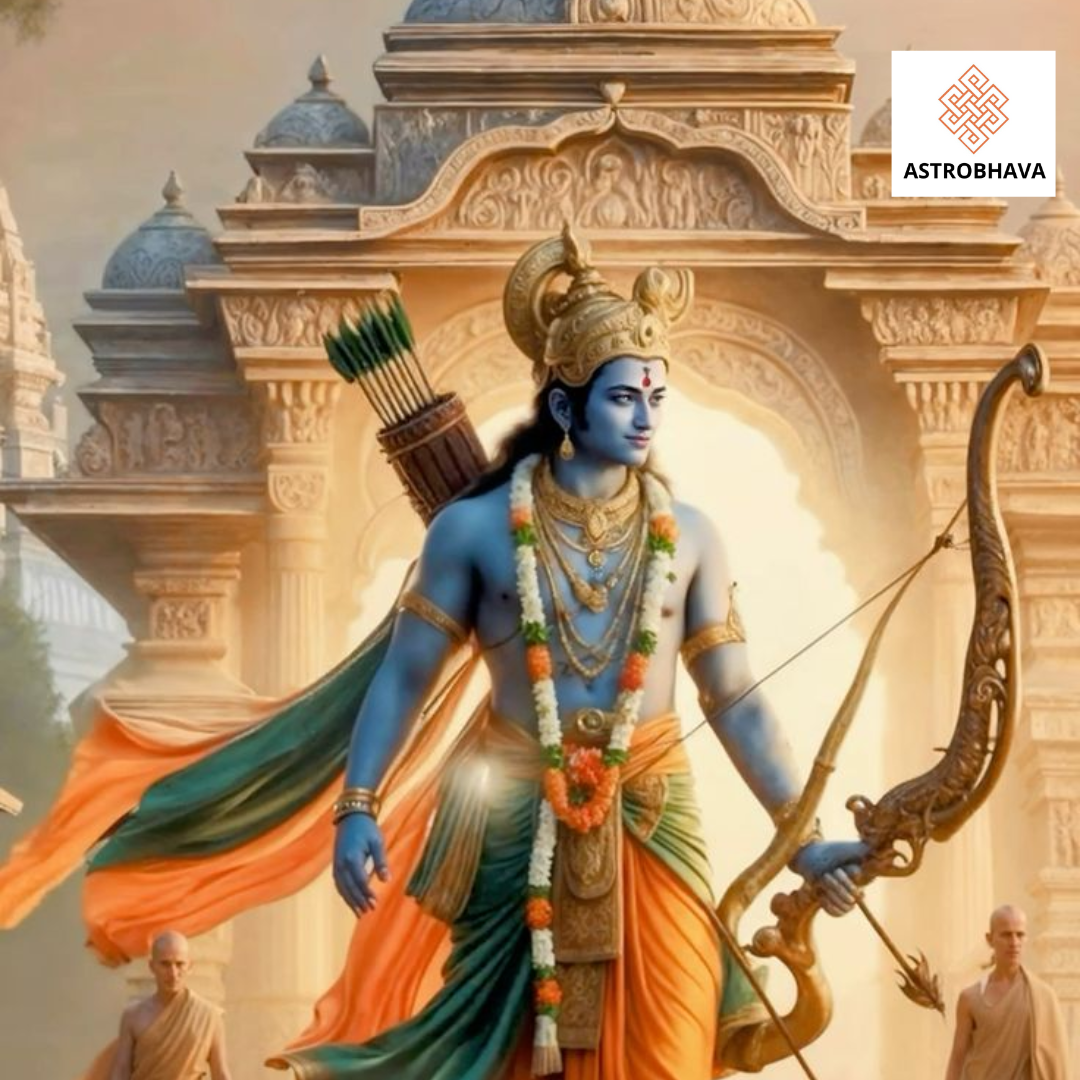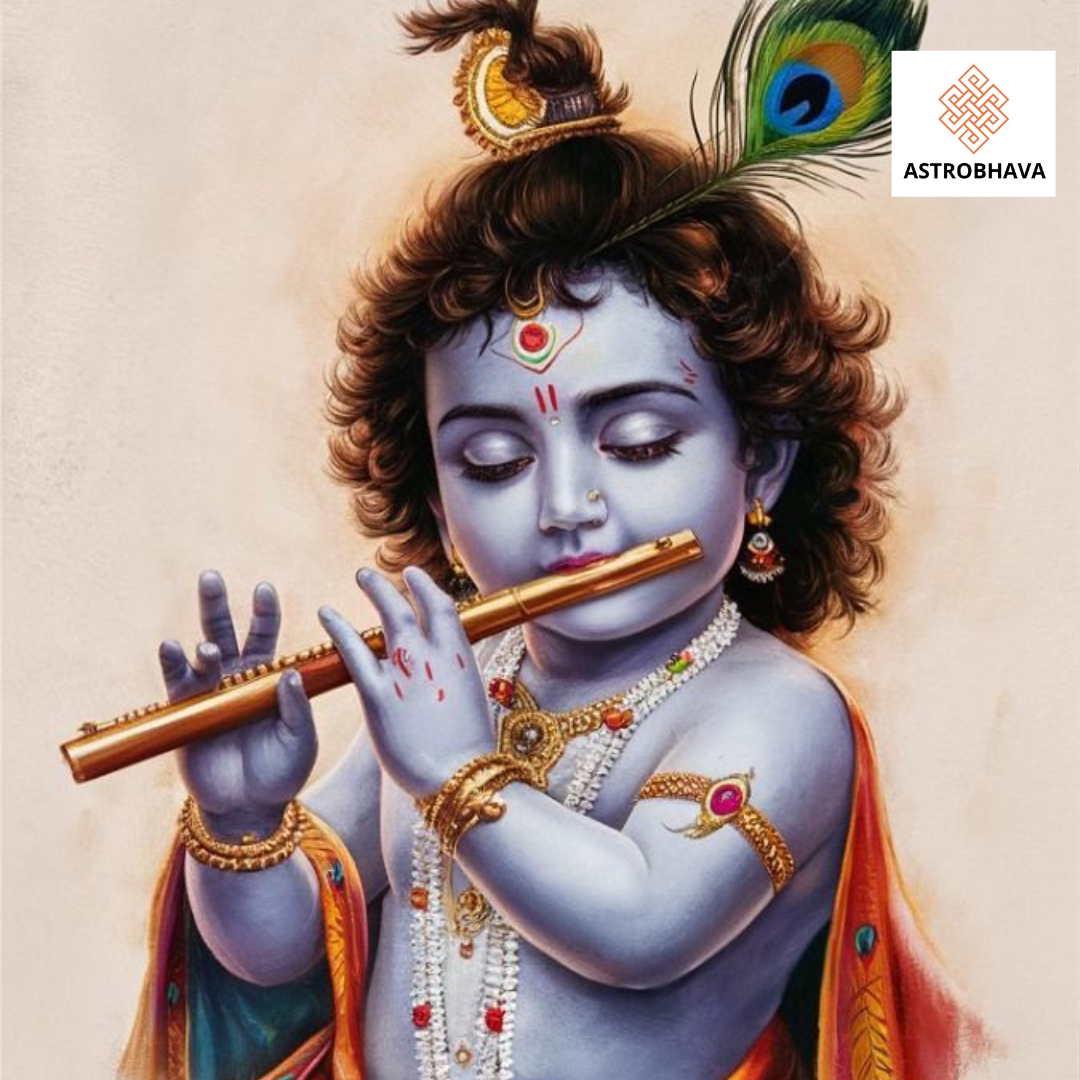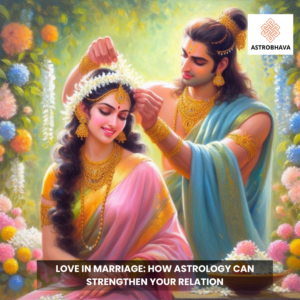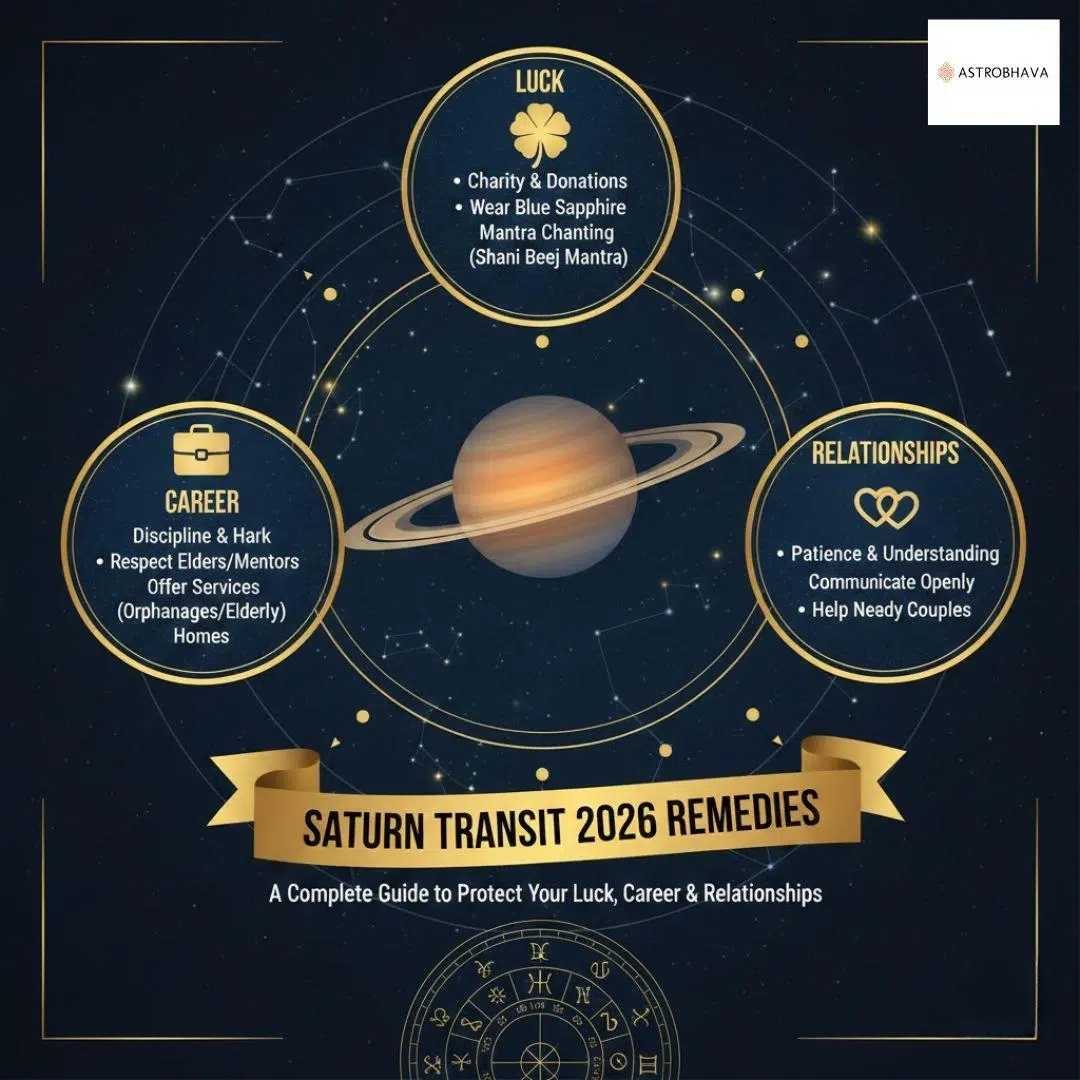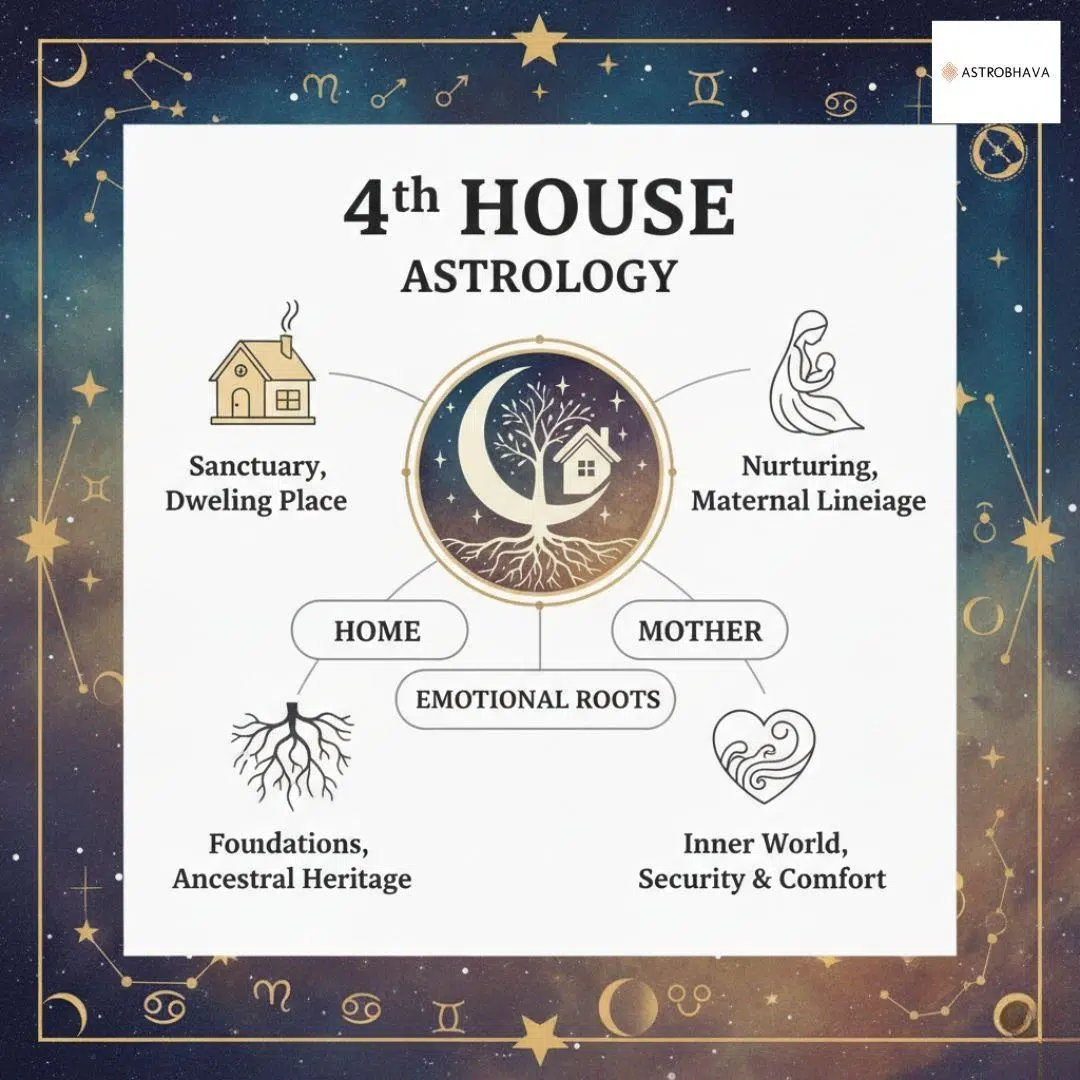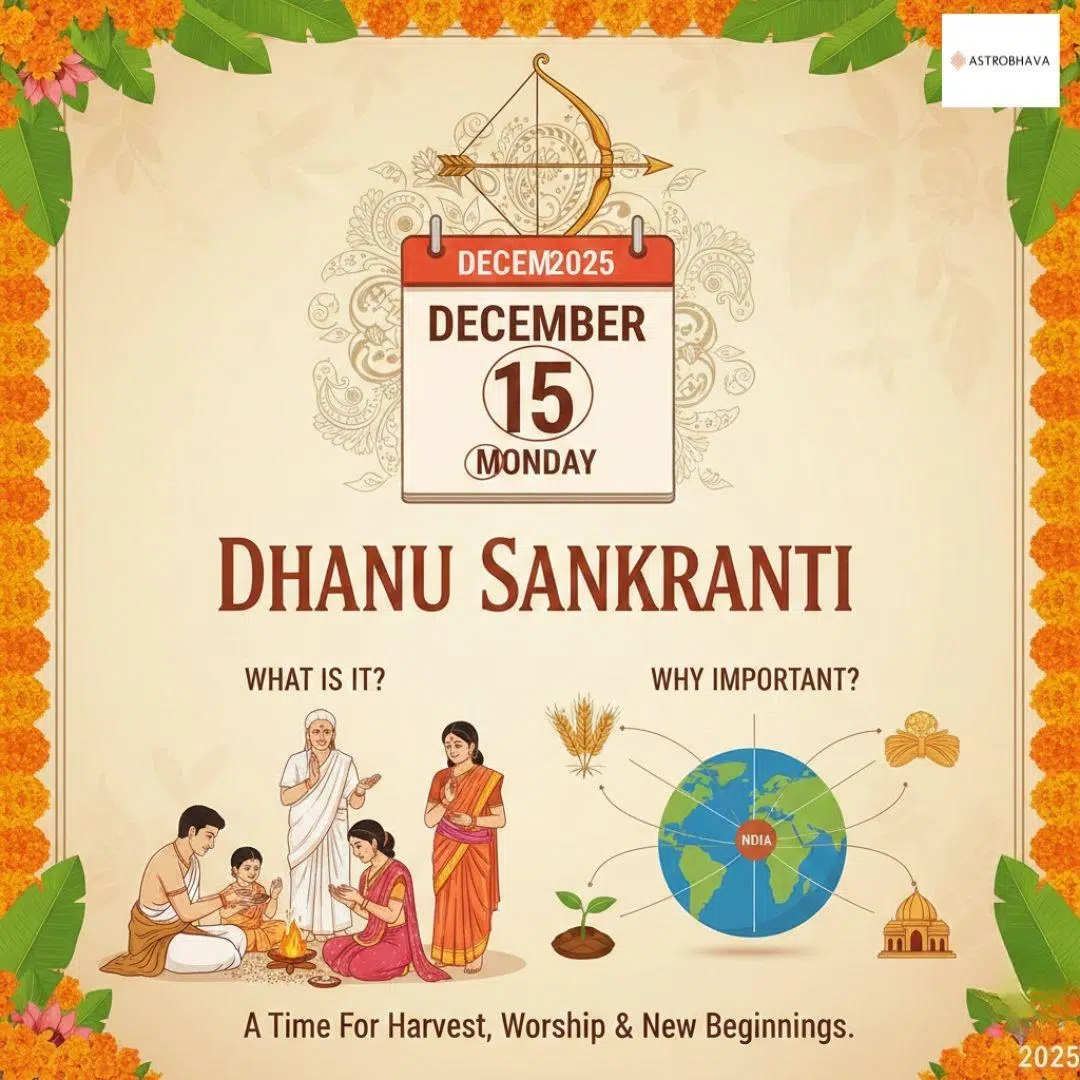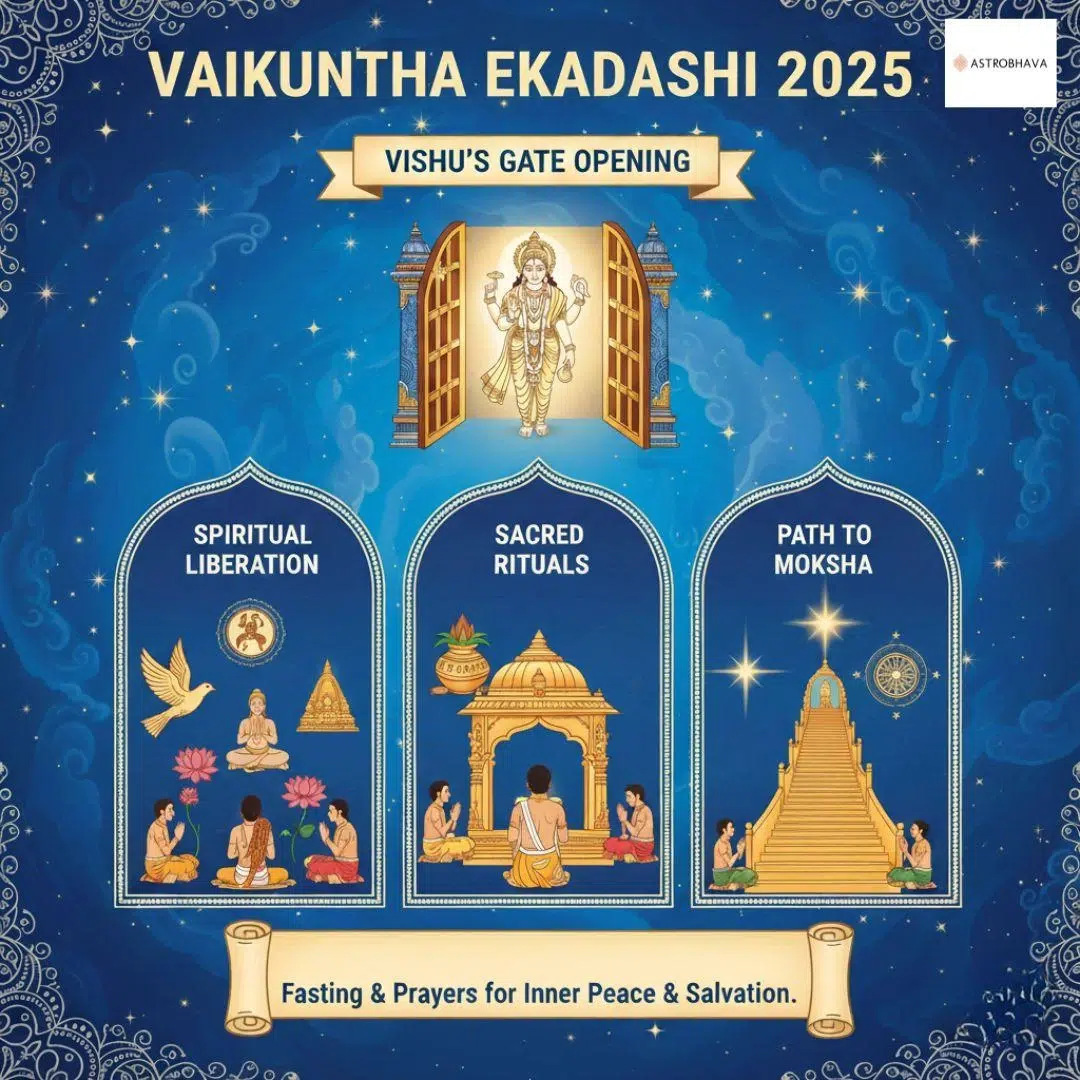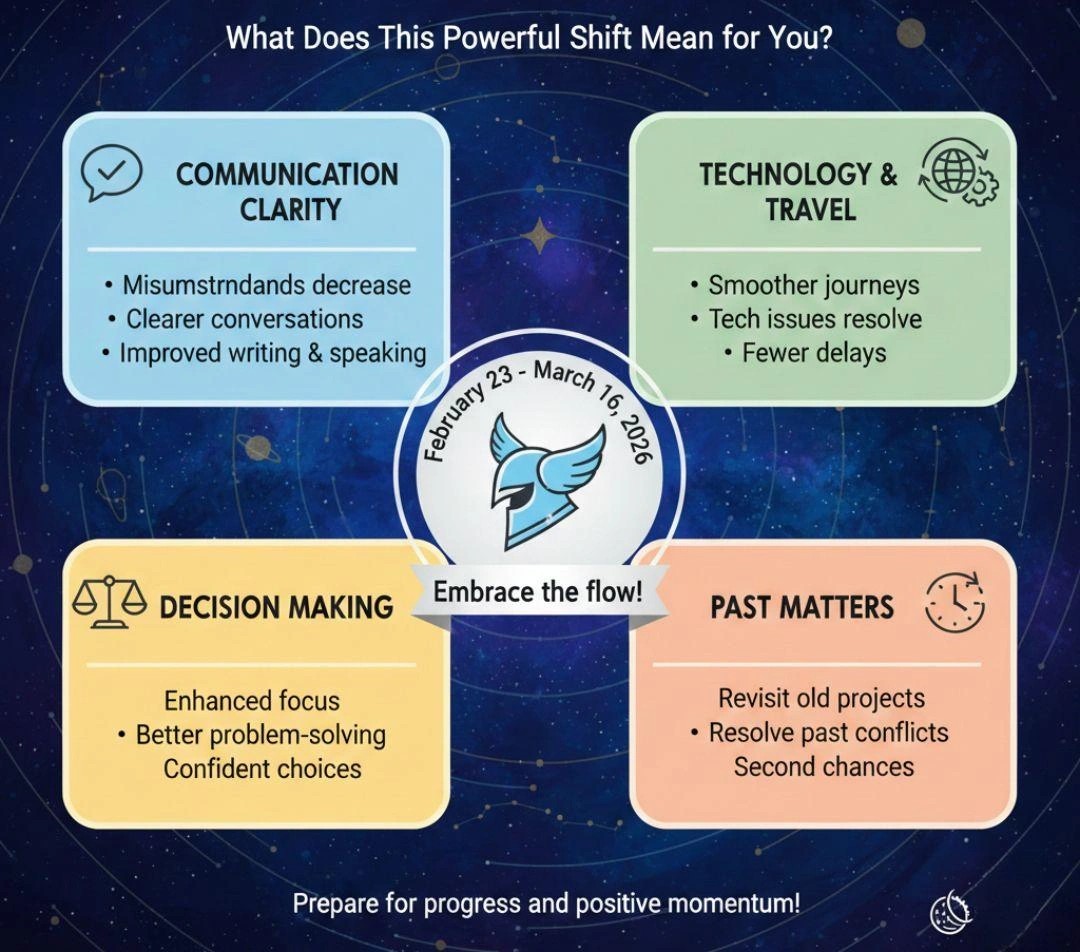Dashavatar of Lord Vishnu: Discovering the Astounding 10 Incarnations
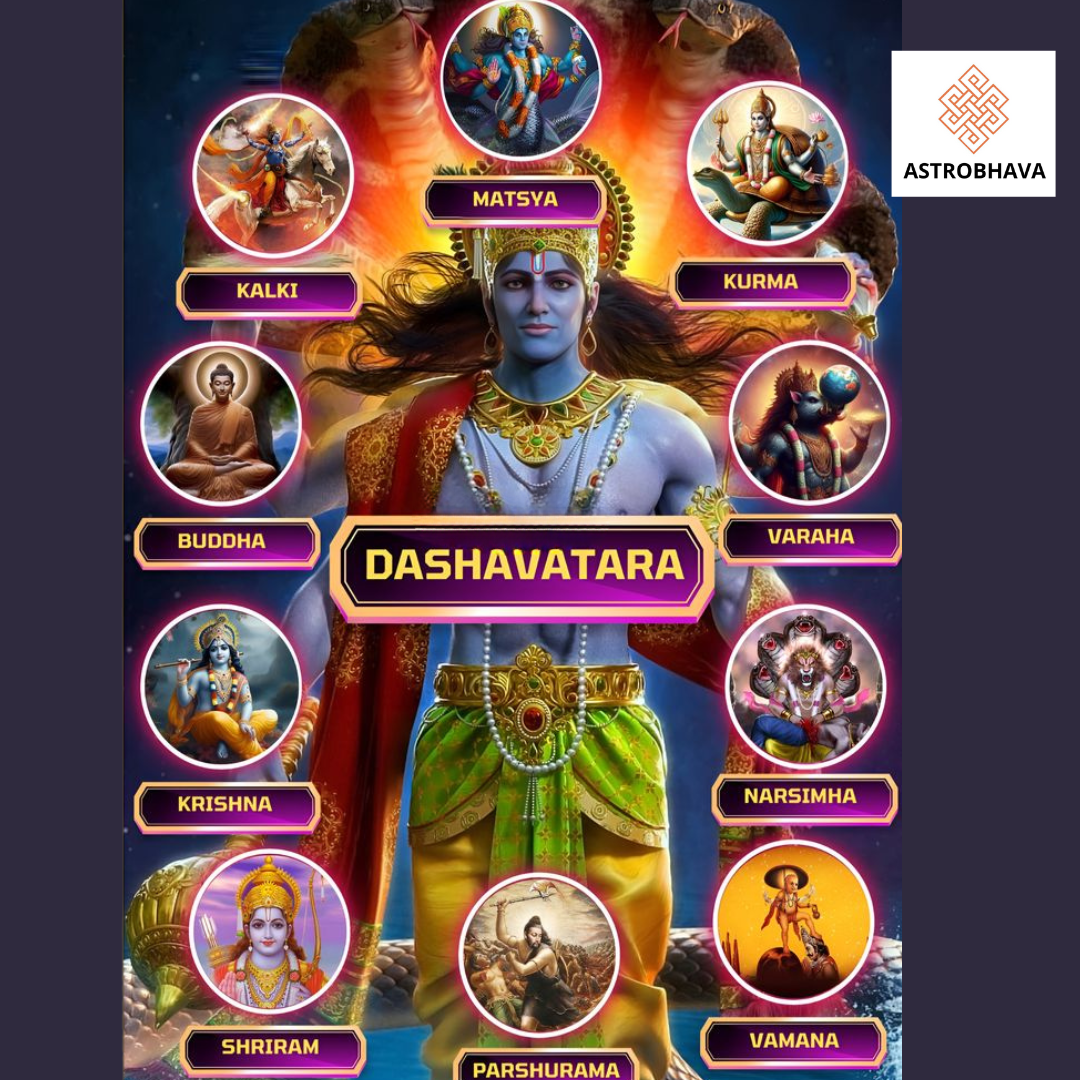
Lord Vishnu, the preserver of the universe, is one of the principal deities in Hinduism. He is known for his divine role in maintaining cosmic order through his ten primary incarnations, collectively known as the Dashavatar of Lord Vishnu. These ten incarnations, as mentioned in various Hindu scriptures, symbolize different ages and the evolution of life and righteousness on Earth. Each of these divine avatars emerged at different periods in history, with a specific mission to restore balance and righteousness.
About Lord Vishnu
Lord Vishnu is regarded as the supreme protector and preserver in Hindu mythology. According to sacred texts, he manifests on Earth whenever there is a decline in righteousness (dharma) and an increase in unrighteousness (adharma). The Dashavatar of Lord Vishnu are divine interventions aimed at restoring cosmic balance. Each incarnation has a unique story, purpose, and significance, illustrating how Vishnu’s divine power has been instrumental in shaping the course of history.
Stories Behind Dashavatar of Lord Vishnu
The Dashavatar of Lord Vishnu consists of ten unique incarnations, each emerging in response to a specific crisis faced by the world. These incarnations are detailed in various Hindu scriptures, including the Vishnu Purana, Bhagavata Purana, and Mahabharata. Each avatar represents an evolutionary milestone, reflecting the transition of life forms from aquatic beings to highly developed human civilizations.
Dashavatar of Vishnu According to Vishnu Puran
The Vishnu Purana is one of the key texts that describe the Dashavatar of Lord Vishnu in detail. It provides insights into the reasons for each incarnation and the impact on the world. According to this scripture, the ten avatars were preordained to occur at different times to restore dharma.
Dasavatharam List
- Matsya (The Fish) – Rescued the Vedas and saved humanity from a great deluge.
- Kurma (The Tortoise) – Supported Mount Mandara during the churning of the ocean.
- Varaha (The Boar) – Rescued Earth (Bhudevi) from the demon Hiranyaksha.
- Narasimha (The Man-Lion) – Killed Hiranyakashipu to protect his devotee, Prahlada.
- Vamana (The Dwarf Brahmin) – Subdued King Bali and restored the cosmic order.
- Parashurama (The Warrior with an Axe) – Eradicated corrupt Kshatriyas to uphold righteousness.
- Rama (The Ideal King) – Defeated the demon king Ravana and upheld dharma.
- Krishna (The Divine Strategist) – Played a pivotal role in the Mahabharata and delivered the Bhagavad Gita.
- Buddha (The Enlightened One) – Taught non-violence and compassion to the world.
- Kalki (The Future Warrior) – Yet to appear; will end the age of darkness and restore righteousness.
Each of these avatars plays a crucial role in shaping human morality, and they are deeply revered across various Hindu traditions.
Dashavatar of Vishnu According to Vishnu Puran
The Dashavatar (दशावतार) refers to the ten principal incarnations of Lord Vishnu, as described in the Vishnu Purana and other Hindu scriptures. According to Hindu belief, whenever dharma (righteousness) declines and adharma (unrighteousness) rises, Lord Vishnu incarnates to restore cosmic balance.
The Ten Avatars of Vishnu
Each of Vishnu’s incarnations serves a unique purpose in maintaining cosmic harmony. Below is a detailed explanation of each avatar and its significance:
1. Matsya Avatar (The Fish Incarnation)
- Purpose: To save the Vedas, protect life during a great deluge, and ensure the survival of wisdom.
- Story:
In ancient times, a demon named Hayagriva stole the sacred Vedas and hid them at the bottom of the cosmic ocean, intending to keep divine knowledge from reaching humans. Meanwhile, a pious king named Satyavrata found a small fish in his hands while performing ablutions in a river. The fish requested protection, and when Satyavrata placed it in a larger vessel, it continued to grow exponentially. Finally, realizing that the fish was none other than Lord Vishnu, the king sought its guidance.
Lord Vishnu, in the Matsya (fish) form, warned Satyavrata of an impending great deluge (pralaya) and instructed him to build a massive boat to save the sages and various life forms. During the flood, Matsya rescued the Vedas from Hayagriva, restored divine knowledge, and guided Satyavrata’s boat to safety. - Significance: Represents the preservation of wisdom and guidance during chaos.
2. Kurma Avatar (The Tortoise Incarnation)
- Purpose: To assist in the churning of the ocean (Samudra Manthan) to obtain the amrita (nectar of immortality).
- Story:
The Devas (gods) and Asuras (demons) sought the elixir of immortality hidden in the depths of the ocean. To extract it, they decided to churn the ocean using Mount Mandara as a churning rod and the serpent Vasuki as a rope. However, the mountain began to sink due to its immense weight.
Lord Vishnu incarnated as a giant tortoise (Kurma) and supported the mountain on his back, allowing the churning to continue. This event led to the emergence of several celestial treasures, including Kamadhenu (divine cow), Lakshmi (goddess of wealth), and the nectar of immortality. - Significance: Symbolizes stability, support, and perseverance in times of struggle.
3. Varaha Avatar (The Boar Incarnation)
- Purpose: To rescue the Earth (Bhudevi) from the demon Hiranyaksha and restore balance.
- Story:
The demon Hiranyaksha dragged Bhudevi (Mother Earth) to the depths of the cosmic ocean, disrupting the balance of the universe. To restore order, Lord Vishnu appeared as a mighty boar (Varaha) and plunged into the ocean. A fierce battle ensued, and after a prolonged fight, Varaha pierced Hiranyaksha with his tusks, defeating him.
Vishnu then lifted Bhudevi on his tusks and restored her position in the universe. - Significance: Represents the protection of nature and righteousness against destructive forces.
4. Narasimha Avatar (The Half-Man, Half-Lion Incarnation)
- Purpose: To protect his devotee Prahlada and destroy the tyrant Hiranyakashipu.
- Story:
Hiranyakashipu, the elder brother of Hiranyaksha, performed severe penance and obtained a boon that made him virtually invincible—he could not be killed by man or beast, during day or night, indoors or outdoors, on land, in water, or in the sky. He became arrogant and prohibited the worship of Lord Vishnu.
However, his own son Prahlada remained devoted to Vishnu. Enraged, Hiranyakashipu attempted to kill Prahlada multiple times, but Vishnu always protected him. Finally, Lord Vishnu appeared as Narasimha (half-man, half-lion) and killed Hiranyakashipu at twilight, on the threshold of his palace, placing him on his lap and using his claws. - Significance: Demonstrates that divine justice prevails, even against seemingly impossible odds.
“Seek the blessings of Lakshmi Narasimha- Order Lakshmi Narasimha yantra now!”
5. Vamana Avatar (The Dwarf Incarnation)
- Purpose: To humble King Mahabali and restore divine order.
- Story:
King Mahabali, a generous but ambitious demon king, gained control over the heavens and the earth. The gods, fearing his growing power, sought Vishnu’s help. Lord Vishnu took the form of a young Brahmin dwarf (Vamana) and requested three paces of land as alms from Mahabali.
When the king agreed, Vamana expanded into a gigantic form (Trivikrama)—with one step, he covered the entire Earth; with the second, he covered the heavens. Having no space left for the third step, Mahabali offered his own head, and Vishnu sent him to the Sutala realm but granted him immortality. - Significance: Teaches humility and the limits of power.
6. Parashurama Avatar (The Warrior with the Axe)
- Purpose: To eliminate corrupt Kshatriya rulers and restore justice.
- Story:
Born as the son of Sage Jamadagni, Parashurama was a Brahmin warrior who carried an axe given by Lord Shiva. Seeing the Kshatriya kings become arrogant and tyrannical, Parashurama took a vow to eliminate them twenty-one times, restoring order. - Significance: Represents righteous warfare and divine justice.
7. Rama Avatar (The Ideal King)
- Purpose: To exemplify dharma (righteousness) and defeat Ravana.
- Story:
Lord Rama, the prince of Ayodhya, followed an ideal life of duty, devotion, and sacrifice. His wife Sita was abducted by Ravana, the demon king of Lanka. With the help of Hanuman and Sugriva, Rama waged war against Ravana, ultimately defeating him and establishing Rama Rajya—an era of righteousness. - Significance: Embodies virtue, duty, and devotion.
8. Krishna Avatar (The Divine Strategist)
- Purpose: To establish dharma and guide humanity.
- Story:
Krishna played a vital role in the Mahabharata, advising Arjuna in the Bhagavad Gita, showcasing divine wisdom. He defeated Kamsa, Shishupala, and Jarasandha, reestablishing righteousness. - Significance: Represents divine love, wisdom, and justice.
9. Buddha Avatar (The Enlightened One)
- Purpose: To teach non-violence and wisdom.
- Story:
Siddhartha Gautama (Buddha) renounced his kingdom to seek truth. He attained enlightenment and taught compassion, non-violence, and detachment. - Significance: Encourages inner peace and wisdom.
10. Kalki Avatar (The Future Warrior)
- Purpose: To destroy evil and establish Satya Yuga.
- Story:
In Kali Yuga, Vishnu will come as Kalki, riding a white horse, wielding a flaming sword, to end corruption and restore virtue. - Significance: Marks the end of Kali Yuga and the rebirth of righteousness.
Rituals Related to Each of the Dashavatars of Vishnu
Each of Lord Vishnu’s ten avatars (Dashavatar) is worshipped through specific rituals, festivals, and sacred observances across different regions of India. Devotees perform these rituals to seek divine blessings, protection, and prosperity. Below is a detailed guide to the rituals associated with each of the Dashavatars.
1. Matsya Avatar (The Fish Incarnation) – Worship & Rituals
- Special Days/Festivals: Matsya Jayanti (celebrated in Chaitra month)
- Rituals:
- Devotees worship Lord Vishnu in his Matsya form and recite the Matsya Purana.
- Sacred river and ocean worship is performed, emphasizing the importance of water and its role in sustaining life.
- Fasting (Vrat) is observed, and devotees offer milk, coconut, and white flowers to Lord Vishnu.
- Charity of water, grains, and clothes is done to help the poor.
2. Kurma Avatar (The Tortoise Incarnation) – Worship & Rituals
- Special Days/Festivals: Kurma Jayanti (Vaishakh Purnima)
- Rituals:
3. Varaha Avatar (The Boar Incarnation) – Worship & Rituals
- Special Days/Festivals: Varaha Jayanti (Bhadrapada month)
- Rituals:
- Devotees observe Varaha Dwadashi Vrat, which includes fasting and prayers.
- Worship of Lord Varaha with red flowers, sindoor, and sweets.
- Reading of the Varaha Purana and chanting Vishnu Sahasranama.
- Special prayers for protecting land and removing obstacles in life.
4. Narasimha Avatar (The Half-Man, Half-Lion Incarnation) – Worship & Rituals
- Special Days/Festivals: Narasimha Jayanti (Vaishakh Shukla Chaturdashi)
- Rituals:
- Devotees fast on Narasimha Jayanti and worship Narasimha Swamy with yellow flowers and special offerings.
- Recitation of the Narasimha Kavacham Stotra to seek divine protection from evil forces.
- Temple rituals include abhisheka with milk, honey, and ghee.
- Devotees offer jaggery, sesame seeds, and bananas to the deity.
5. Vamana Avatar (The Dwarf Incarnation) – Worship & Rituals
- Special Days/Festivals: Vamana Jayanti, Onam (celebrated in Kerala)
- Rituals:
- Devotees worship Lord Vamana with offerings of yellow flowers, bananas, and rice-based sweets.
- The Vishnu Sahasranama and Vamana Stotra are recited.
- In Kerala, Onam festival celebrates King Mahabali’s return, and grand feasts (Onasadya) are prepared.
- Devotees perform charity (daan), especially donating umbrellas and clothes to Brahmins.
6. Parashurama Avatar (The Warrior with the Axe) – Worship & Rituals
- Special Days/Festivals: Parashurama Jayanti (Vaishakh Tritiya)
- Rituals:
- Worship of Lord Parashurama by offering tulsi, fruits, and coconut.
- Reading of the Parashurama Katha and performing yajnas (fire rituals).
- Devotees observe fasting and practice Brahminic rituals such as learning the Vedas.
- Some devotees take a holy dip in rivers and offer food to the poor.
“Seek the Blessings of Lord Parasuram: Book Your Parasuram Japa Now”
7. Rama Avatar (The Ideal King) – Worship & Rituals
- Special Days/Festivals: Rama Navami, Diwali, Dussehra
- Rituals:
- Rama Navami is celebrated with fasting, bhajans, and reading of the Ramayana.
- Diwali marks Rama’s return to Ayodhya, and devotees light lamps (diyas) and offer prayers to Lord Rama and Sita.
- On Dussehra, the victory of Rama over Ravana is celebrated with effigy burning and Ram Leela performances.
- Charity and donation of food and clothes are performed in temples.
“Experience the Divine Energy of Rama Homa: Perform the Sacred Ritual for Spiritual Growth”
8. Krishna Avatar (The Divine Strategist) – Worship & Rituals
- Special Days/Festivals: Janmashtami, Govardhan Puja, Rasa Lila
- Rituals:
- Janmashtami (Krishna’s birth festival) is celebrated with fasting, bhajans, and midnight prayers.
- Devotees perform abhisheka with milk, honey, ghee, and curd to Krishna idols.
- Special rituals include dahi handi (pot-breaking ceremony) and Rasa Lila (re-enactment of Krishna’s dance with the gopis).
- Devotees offer butter, milk sweets, and fruits to Krishna.
“Seek the Blessings of Lord Krishna: Book Your Santana Gopala Puja Now”
9. Buddha Avatar (The Enlightened One) – Worship & Rituals
- Special Days/Festivals: Buddha Purnima (Vaishakh Purnima)
- Rituals:
- Devotees visit Buddha temples and stupas to offer prayers.
- Meditation and chanting of Buddhist mantras are performed.
- Acts of charity, feeding the poor, and releasing caged animals are encouraged.
- Lighting of lamps and incense sticks symbolizes wisdom and enlightenment.
10. Kalki Avatar (The Future Warrior) – Worship & Rituals
- Rituals:
- Worship of Lord Vishnu in his universal form, praying for the end of Kali Yuga’s evils.
- Devotees chant the Kalki Stotra and Vishnu Sahasranama.
- Some offer prayers for righteous rule, peace, and moral awakening.
Each of these celebrations allows devotees to connect with the divine, seek blessings, and imbibe the values represented by these avatars.
Conclusion
The Dashavatar of Lord Vishnu represents the divine cycle of birth, evolution, and restoration of dharma. Understanding these ten incarnations provides deep insights into Hindu mythology and its spiritual teachings. Each avatar’s emergence reflects the progression of human consciousness and the eternal fight against adharma. Worshiping these incarnations and following their teachings can guide devotees toward righteousness and spiritual enlightenment.
To explore your personal connection with these divine avatars and understand their influence in your life, consult with expert astrologers at AstroBhava today! Gain deeper insights into your spiritual path and receive guidance on honoring Vishnu’s divine presence in your life.
FAQs
1. What is the significance of the Dashavatar of Lord Vishnu?
The Dashavatar of Lord Vishnu represents the cosmic cycle of creation, preservation, and destruction. Each avatar emerges to restore dharma, ensuring the universe’s balance is maintained.
2. Which is the most powerful avatar of Vishnu?
All avatars serve a divine purpose, but Krishna and Rama are among the most revered due to their significant roles in Hindu epics.
3. Why is Buddha included in the Dashavatar of Lord Vishnu?
Buddha is included as an avatar because his teachings of non-violence and compassion aligned with restoring balance in the world. His emphasis on dharma helped guide societies toward spiritual enlightenment.
4. What is the purpose of Kalki Avatar?
Kalki is prophesied to appear in the future to eradicate evil, destroy adharma, and establish a new era of righteousness, ushering in the next Yuga cycle.
5. How can I worship Lord Vishnu’s avatars?
Each avatar has specific festivals and rituals associated with them. Devotees can perform pujas, read scriptures, and chant Vishnu mantras to seek blessings. Engaging in acts of kindness and upholding dharma in daily life also honors Vishnu’s presence.
Embrace the divine power of the Dashavatar of Lord Vishnu and enhance your spiritual journey with insights from AstroBhava!
Categories
- 10th House meaning
- 12th house astrology
- 12th House Moon meaning
- 1st house in astrology
- 2025 astrology
- 2025 festivals
- 2025 planetary movements
- 27 nakshatras
- 2nd house astrology finance
- 2nd house in astrology
- 2nd house in astrology explained
- 3rd house in astrology
- 4th house in astrology
- 9th house moon astrology
- Antardasha
- aries personality
- aries traits
- aries zodiac sign
- ascendant in astrology
- astro guide
- astro predictions 2025
- astro remedies
- astro tips
- Astrobhava
- Astrobhava astrology
- Astrobhava blog
- astrological effects
- astrological guidance
- astrological love compatibility
- Astrological love languages
- Astrological Remedies
- astrology
- astrology 2025
- astrology 2026
- astrology 2nd house meaning
- astrology benefits
- astrology calculator
- astrology career path
- astrology career prediction
- astrology compatibility
- astrology consultation
- astrology for business
- astrology for wealth
- astrology gemstones
- astrology guide
- Astrology Guides
- astrology houses
- astrology houses guide
- astrology insights
- astrology love guide
- astrology lucky color
- astrology predictions
- astrology remedies
- astrology remedies for job
- Astrology Remedies for Wellness
- astrology rituals
- astrology solutions
- astrology soulmate signs
- astrology sun planet
- astrology tips
- auspicious yogas
- Bhagavad Gita Jayanti
- birth chart
- birth chart analysis
- birth chart reading
- birth star matching
- business astrology
- business partnership astrology
- business success astrology
- career astrology
- Career Astrology & Personal Growth
- career astrology remedies
- career by nakshatra
- career growth remedies
- career stagnation remedies
- color astrology
- communication astrology
- compatibility chart
- Cosmology
- Dasha
- dasha period calculator
- Dasha system
- Dhanu Sankranti 2025
- divine blessings
- dosha
- dosha remedies
- dreams interpretation
- dreams meaning
- Ekadashi benefits
- Ekadashi rituals
- Ekadashi vrat
- emotional astrology
- emotional compatibility
- emotional growth astrology
- emotional healing
- entrepreneurial astrology
- Festivals & Vedic Rituals
- financial astrology
- fire sign aries
- first house meaning
- fourth house meaning
- Gaja Kesari Yoga
- Gaja Kesari Yoga benefits
- gemstone astrology
- gemstone benefits
- Gita Jayanti 2025 astrology
- Gita Jayanti astrology
- hindu astrology
- Hindu calendar 2025
- Hindu fasting
- Hindu Festivals
- Hindu festivals 2025
- Hindu festivals astrology
- hindu rituals
- Homa and Fire Rituals (Yagna)
- home and family astrology
- horoscope
- horoscope 2025
- horoscope analysis
- horoscope colors
- horoscope correction
- horoscope guide
- horoscope matching
- horoscope reading
- horoscope remedies
- horoscope yoga benefits
- Indian astrology
- insightful trade
- Japa
- job astrology
- Jupiter Moon yoga
- kundli matching
- kundli reading
- lagna in astrology
- Latcharchana remedies
- list of 27 nakshatras
- lord of nakshatra
- love astrology
- love horoscope
- love match astrology
- lucky color for zodiac signs
- lucky gemstones
- lunar rituals
- lunar signs
- Mahadasha
- Mahadasha Calculator
- mahadasha effects
- Mahadasha periods
- Mahadasha prediction
- Mahadasha remedies
- mahadasha results
- Makar Sankranti
- Mantra
- Margashirsha puja
- Margashirsha Purnima 2025
- Margashirsha rituals
- Marriage Auspicious Day
- marriage matching
- match making astrology
- Mercury direct 2025
- mercury direct meaning
- Mercury planet
- Mercury Retrograde
- Mercury Retrograde dates
- Mercury Retrograde effects
- Moon and profession
- Moon astrology
- Moon astrology insights
- Moon effects in astrology
- Moon house meaning
- Moon in 10th House
- Moon in 11th House
- Moon in 12th House
- Moon in 6th House
- Moon in 6th House effects
- Moon in 6th House remedies
- Moon in 7th House
- Moon in 7th House astrology
- Moon in 7th House effects
- Moon in 7th House love
- Moon in 7th House marriage
- Moon in 7th House meaning
- Moon in 7th House remedies
- Moon in 8th House
- moon in 8th house love
- moon in 8th house marriage
- moon in 9th house
- moon in 9th house effects
- Moon in Astrology
- moon in eighth house effects
- Moon in Eleventh House meaning
- moon in ninth house meaning
- Moon in Sixth House astrology
- Moon in tenth house career
- moon meaning
- Moon placement
- Moon placement in 7th House
- nadi astrology
- Nakshatra and Mahadasha
- nakshatra astrology
- nakshatra calculator
- nakshatra career guide
- nakshatra characteristics
- Nakshatra compatibility
- nakshatra guide
- nakshatra healing
- nakshatra job compatibility
- Nakshatra Lord
- nakshatra matching for marriage
- nakshatra meaning
- Nakshatra Remedies
- nakshatra ruler
- nakshatras
- natal chart analysis
- natal chart meaning
- numerology
- online astrology tool
- Panchami Festival
- partnership compatibility
- past karma
- past karma astrology
- personality in astrology
- Pilgrimage
- planetary dasha calculator
- planetary insights
- planetary mahadasha
- planetary periods
- planetary remedies
- planetary retrograde
- planetary transits 2025
- planets houses
- positivity rituals
- powerful astrology solutions
- Progency
- Puja & Rituals
- puja remedies
- Purnima 2025
- relationship astrology
- Relationships
- religious dates India
- remove career blockages
- retrograde meaning
- rudra puja
- Rudraksha and gemstone
- sankranti 2025
- Sankranti puja
- sankranti rituals
- Saphala Ekadashi 2025
- Saturn japa
- Saturn remedies
- saturn transit 2026 remedies
- Shani dosha
- Shani japa benefits
- Shani mantra
- shani remedies
- Spiritual Astrology
- spiritual benefits
- spiritual growth
- Spiritual Guide
- spiritual healing
- Spiritual Practices and Chanting
- spiritual remedies
- Spiritual Rituals and Personal Empowerment
- spiritual significance
- Spiritual Tools & Personal Growth
- Spiritual Wellness and Protection
- Spirituality and Rituals
- Spirituality or Vedic Rituals
- star sign compatibility
- sun and zodiac signs
- Sun in Astrology
- sun in horoscope
- sun planet effects
- sun planet meaning
- sun power in astrology
- temple rituals
- transit astrology
- twin flame astrology
- Twin Flame Astrology Signs
- twin flame compatibility
- twin flame signs
- Utpanna Ekadashi 2025
- Utpanna Ekadashi dates
- Utpanna Ekadashi rituals
- Utpanna Ekadashi significance
- Vaikuntha Dwar
- Vaikuntha Ekadashi 2025
- Vastu Tips
- Vedic Astrology
- vedic astrology tools
- Vedic remedies
- Vivaah Panchami
- Vivaah Panchami Puja
- Vivaah Panchami Rituals
- Vivaah Panchami Significance
- vrat guide
- vrischik sankranti puja
- vrishchik rashi
- Vrishchik sankranti
- yantras
- yoga effects
- zodiac astrology
- zodiac colors meaning
- zodiac compatibility
- zodiac lucky colors
- zodiac moon traits
- zodiac relationships
- Zodiac Signs

